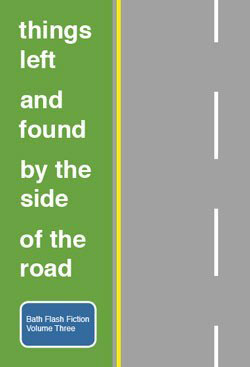Believe it or not, the inspiration for this article came whilst talking to my sister’s spoodle, Harley. I like talking to Harley because, like many dogs, now and then he’ll tilt his head like he’s really listening. People head-tilt too. I know I do. When decorating, after trying a new colour out on a wall, I’ll take a step back and tilt my head. My partner will emerge from the changing room in a clothes shop wearing a new dress and I’ll tilt my head. Sometimes, I’ll tilt my head when reading back a paragraph I’ve written. There are a few explanations for why humans, and indeed dogs, do this. My favourite though, describes how it is a way of actually altering how we perceive what it is we’re trying to comprehend. This can help us interpret information in a different, hopefully beneficial way.
For me, I see flash fiction doing something similar for the reader. My favourite examples of flash fiction emulate the head-tilt, depicting the world in an altered way. The latest Bath Flash Fiction Collection: Volume Three, contains 133 excellent examples of flash fiction, some of which I want to refer to here, in an attempt to look at the idea inspired by Harley, my sister’s spoodle.
Before I look at the Bath Collection, I’d like to tell you about a book I’ve been studying, called ‘The Story Grid,’ written by an experienced, well-regarded editor called Shawn Coyne. His book is a guide to writing and editing novels, but it has made me think about the structure of flash fiction. The five part structure used in analysing stories has been used many times before (such as in Freytag’s Pyramid), and Coyne employs a similar outline: 1. Inciting Incident, 2. Progressive Complication, 3. Crisis, 4. Climax, 5. Resolution.
Clearly, the opening of flash fiction is very important, so I want to focus on Coyne’s notion of the Inciting Incident, which he claims, ‘must upset the life balance of your lead protagonist(s). It must make them uncomfortably out of sync…for good or for ill.’ He goes on to explain how the Inciting Incident might be ‘caused’ (an active choice made by the protagonist), or ‘coincidental’ (something happening to the protagonist). Another way of putting it might be there needs to be conflict. I hear this a lot during discussions on story, so I want to look at some of the stories in the Bath Collection, and analyse how successful flash fiction addresses the idea of an Inciting Incident and conflict.
K.M. Elkes’ fantastic winning flash fiction, ‘Extremities,’ is a good place to begin, because it uses a clear and intriguing Inciting Incident: ‘The way Bobby told it, one minute he was working the chainsaw and the next he was on the forest floor, wondering why there was nothing on the end of his arm.’ In the very first line, the protagonist’s life balance is certainly upset. We might also claim there is conflict here, namely between a man and a chainsaw. K.M. Elkes’ story is memorable because of the inciting incident, a powerful image that is made all the more memorable because of the way the story is narrated with an off-hand (forgive the pun), almost dispassionate tone.
Lee Nash’s story in the collection: ‘When The Rubber Hits The Road,’ also employs a vivid inciting incident that shows conflict: ‘Everything conspired against him, first stealing the flames he’d kindled and torching his thatched cottage, then tearing away the corrugated iron roof of the home he’d built in its place…’ There is an energy running through this flash, expressed in the Inciting Incident and Conflict. Here we have conflict between man and nature, a conflict that continues throughout the story.
In both K.M. Elkes’ and Lee Nash’s stories, the inciting incidents are coincidental, in that what happens, happens to the protagonist. This sort of conflict intrigues the reader because, well, readers love conflict and drama. The reader wants to know what the result of the conflict might be.
What I find interesting, is how Inciting Incidents used in flash fiction do not always use clear conflict, as such. There might be something in the word, ‘conflict,’ that is unhelpful for flash fiction writers. I’ve started to think how the idea of the head-tilt might be a better way of capturing what many flash fiction stories achieve in the Inciting Incident.
This idea of the head-tilt is used in cinematography and photography with something called ‘The Dutch Angle,’ or ‘Dutch Tilt.’ If you’ve ever watched the 1960s TV series of Batman, when the camera is tilted, you’ll know what this is. Put simply, it is when the camera is tilted so the angles of what is being filmed run opposite to the angles of the frame itself. This angle can create a number of emotions, such as confusion, uneasiness, or tension. But essentially, it is a way of looking at the ordinary world in a new way. For me, this is what literature, and in particular, flash fiction does so well.
 We can use some examples from the Bath Collection: Volume Three to explore this idea.
We can use some examples from the Bath Collection: Volume Three to explore this idea.
Fiona J. Mackintosh’s winning flash, ‘Siren,’ opens with: ‘In the wet slap of the haar, the lassies slit the herring mouth to tail and pack them into briny barrels.’ This is a fantastic opening line, filled with description that makes the reader see and hear what’s happening. But for me, the Inciting Incident comes at the end of the first paragraph: ‘She has the juice of silver fishes in her veins — it’s in the raised blue of her wrists, her raw fingers, in the taste of oysters when I lick her down below, her skirt canted up and knees apart.’ This is a wonderful example of description making the reader view the world differently, by tilting it. There’s the metaphor of ‘silver fishes in her veins,’ and the suggestive action of a woman’s ‘skirt canted up and knees apart.’ The surprising language used throughout this flash tilts the reader’s head, making them view the world differently.
The third winning story in the collection, by Jo Gatford, that gives the collection its title: ‘Things Left And Found By The Side Of The Road,’ again asks the reader to tilt their head. Here’s the first line: ‘Baby car seats, sometimes with babies in them, swiftly recovered.’ This is another wonderful Inciting Incident because it asks the reader to visualise something specific in an unusual setting. we see a car seat with a baby inside it, sitting on the side of the road, not far from traffic. This is a frightening and disturbing image, made all the more unsettling when followed with the line: ‘Nettles flourishing in the face of toilet breaks.’ The contrast between a baby in a car seat and nettles flourishing on the side of the road forces us to hold both images in our mind simultaneously.
‘The Undertaker’s Jolly,’ by Conor Houghton opens with an intriguing Inciting Incident: ‘On the first weekend of every May, just as the whitethorn makes the hedgerows so beautiful that it is an agony to know you could never count every petal, all the undertakers in Limerick go on their annual trip.’ The opening sentence builds with two subordinate clauses, leading to a main clause that states a number of undertakers have left on an annual trip. This is the moment that makes the reader tilt their head and ask questions. Undertakers really do that? What do they talk about? Notice also, how the reference to the hedgerows, to spring and new growth, contrasts with the central theme of mortality.
Tim Craig’s flash, ‘Northern Lights,’ opens with the line: ‘After an hour or so, I decided to ask him about the tooth.’ This is an effective opening line as it raises the question: what’s wrong with the tooth? The Inciting Incident is expressed a few sentences later when we discover the tooth is hanging on a piece of cotton from the sun visor and Pavel says, ‘It was my father’s.’ The specificity in the opening of this story helps the reader visualise the tooth ‘dancing back and forth,’ and again asks us to tilt our head and wonder what the meaning of the tooth being there might be.
This is a wonderful collection and every story could be analysed in this way. But the final Inciting Incident I’d like to look at, comes from Elisabeth Ingram Wallace, in her story, ‘Satin Nightwear For Women Irregular.’ It opens with: ‘The walk to the allotment is wet and full of cats, taut muscled screams darting under cars. It’s clunky, carrying all the bulbs she hoarded in one plastic bag, a bin liner, stretched to a thin translucent skin.’ Again, there is specificity here for the reader. And so much of it tilts the world in some way. There is the image of a wet allotment, of cats ‘darting under cars,’ of a ‘bin liner, stretched to a thin translucent skin.’ The Inciting Incident, I would argue, occurs when the protagonist plants the bulbs: ‘Ten halogen, twenty-two bayonet, and thirty-seven screw bulbs.’ This is a great example of how flash asks us to tilt our heads and look at the world in a new way. Why would the protagonist plant these? What will happen?
Now, when I read flash, I’m on the lookout for the Inciting Incident. And what is so great about flash fiction, is that because of its brevity, these tend to occur, if not in the first sentence, certainly in the first hundred words or so. As readers of flash fiction, we don’t have to wait long before we are introduced to conflict, or a moment that demands we tilt our heads and comprehend the word in an altered, intriguing, and often surprising way.
***
Adam Lock is a writer of short fiction from the Black Country in the UK. He’s published over sixty pieces of flash fiction and short stories both online and in print. Links to these stories can be found on his website. He won the TSS Summer 2018 Flash Fiction Competition, the STORGY Flash Fiction Competition 2018, and has been placed and shortlisted in many others, including twice for the Bath Flash Fiction Award, and once for the Kathy Fish Flash Fiction Award. He’s been nominated for the Best Small Fiction Anthology, and for the BIFFY 50. Adam is also the author of the novella-in-flash, ‘Dinosaur,’ published by Ellipsis Zine.

